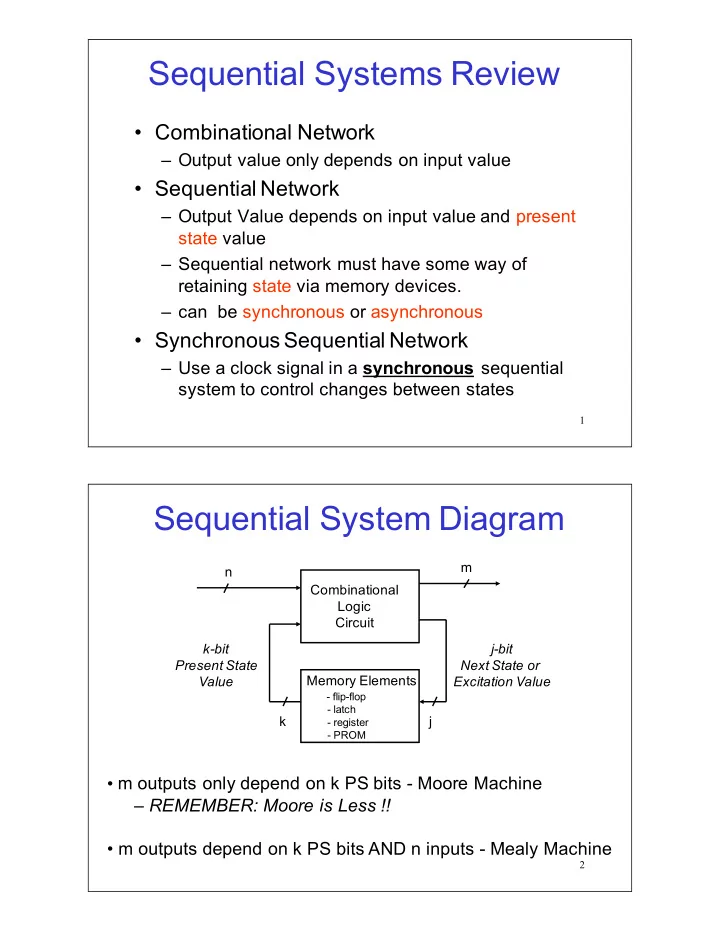

Sequential*Systems*Review • Combinational*Network – Output*value*only*depends*on*input*value • Sequential*Network – Output*Value*depends*on*input*value*and*present* state value – Sequential*network*must*have*some*way*of* retaining*state via*memory*devices. – can**be*synchronous or*asynchronous • Synchronous*Sequential*Network – Use*a*clock*signal*in*a* synchronous sequential* system*to*control*changes*between*states 1 Sequential*System*Diagram m n Combinational Logic Circuit k"bit j"bit Present+State Next+State+or+ Value Memory*Elements Excitation+Value G flipGflop G latch k j G register G PROM • m*outputs*only*depend*on*k*PS*bits*G Moore*Machine – REMEMBER:+Moore+is+Less+!! • m*outputs*depend*on*k*PS*bits*AND*n*inputs*G Mealy*Machine 2
Controller*Block*Diagrams 3 Clock*Signal voltage P w G pulse*width*(in*seconds) τ - period*(in*seconds) time f =* 1/ τ f G frequency*(in*Hertz) D C =* P w / τ duty*cycle G ratio*of*pulse*width*to*period*(in*%) 4
Clock*Signal*Example What*is*the*pulseGwidth*of*a*4.77*MHz*clock* with*a*30%*duty*cycle? 5 Clock*Signal*Example What*is*the*pulseGwidth*of*a*4.77*MHz*clock*with*a* 30%*duty*cycle? τ =*1/ f =*(4.77×10 6 ) G1 =*2.096*×10 G7* =*210*ns 6
Clock*Signal*Example What*is*the*pulseGwidth*of*a*4.77*MHz*clock*with*a* 30%*duty*cycle? τ =*1/ f =*(4.77×10 6 ) G1 =*2.096*×10 G7* =*210*ns Pw =*(duty*cycle)*× τ =*(0.3)*× (210*ns)*=*63*ns 7 Storage*Elements 8
D*FF,**D*Latch*operation C for FF, G for latch D input Q (FF) Q (DL) 9 D*FF,**D*Latch*operation C for FF, G for latch D input Q (FF) Q (DL) 10
Other*State*Elements J K Q(t+1) J JK*can*be*useful*for* 0 0 Q(t) Q single*bit*flags*with* 0 1 0 C separate*set(J),* 1 0 1 reset(K)*control. 1 1 Q’(t) K RARELY*USED T T Q(t+1) Can*be*useful*for* Q 0 Q(t) asynchronous*counter* 1 Q’(t) design. C RARELY*USED 11 DFFs*are*most*common • Most*FPGA*families*only*have*DFFs • DFF*is*fastest,*simplest*(fewest*transistors)* of*FFs • Other*FF*types*(T,*JK)*can*be*built*from* DFFs • We*will*use*DFFs*almost*exclusively*in*this* class – Will*always*use*edgeGtriggered*state*elements*(FFs),* not*level*sensitive*elements*(latches). 12
Synchronous*vs*Asynchronous* Inputs Synchronous*input:**Output*will*change*after*active*clock*edge Asynchronous*input:**Output*changes*independent*of*clock State*elements*often*have*async*set,*reset* S control. D D*input*is*synchronous*with*respect*to*Clk Q C S,*R*are*asynchronous.**Q*output*affected*by* R S,*R*independent*of*C.**Async*inputs*are* dominant*over*Clk. 13 D*FF*with*async*control CLK D input Q (FF) Reset Set 14
DGFlipGFlop*with*Async.*Set/Res 1 15 DGFlipGFlop*with*Async.*Set/Res 16
DGFlipGFlop*with*Sync.*Set/Res 1 17 DGFlipGFlop*with*Sync.*Set/Res 18
FF*Timing • Propagation*Delay – C2Q:***Q*will*change*some*propagation*delay* after*change*in*C.**Value*of*Q*is*based*on*D* input*for*DFF. – S2Q,*R2Q:**Q*will*change*some*propagation* delay*after*change*on*S*input,*R*input – Note*that*there*is*NO*propagation*delay*D2Q*for* DFF! – D*is*a*Synchronous*INPUT,*no*prop*delay*value* for*synchronous*inputs 19 Setup,*Hold*Times • Synchronous*inputs*(e.g.**D)**have*Setup,* Hold*time*specification*with*respect*to*the* CLOCK*input • Setup*Time:**the*amount*of*time*the* synchronous*input*(D)*must*be* stable before the*active*edge*of*clock • Hold*Time:*the*amount*of*time*the* synchronous*input*(D)*must*be* stable+after the*active*edge*of*clock. 20
Setup,*Hold*Time t su t hd C Stable D changing D changing If*changes*on*D*input*violate*either*setup*or*hold* time,*then*correct*FF*operation*is*not*guaranteed. Setup/Hold*measured*around*active*clock*edge. 21
Recommend
More recommend